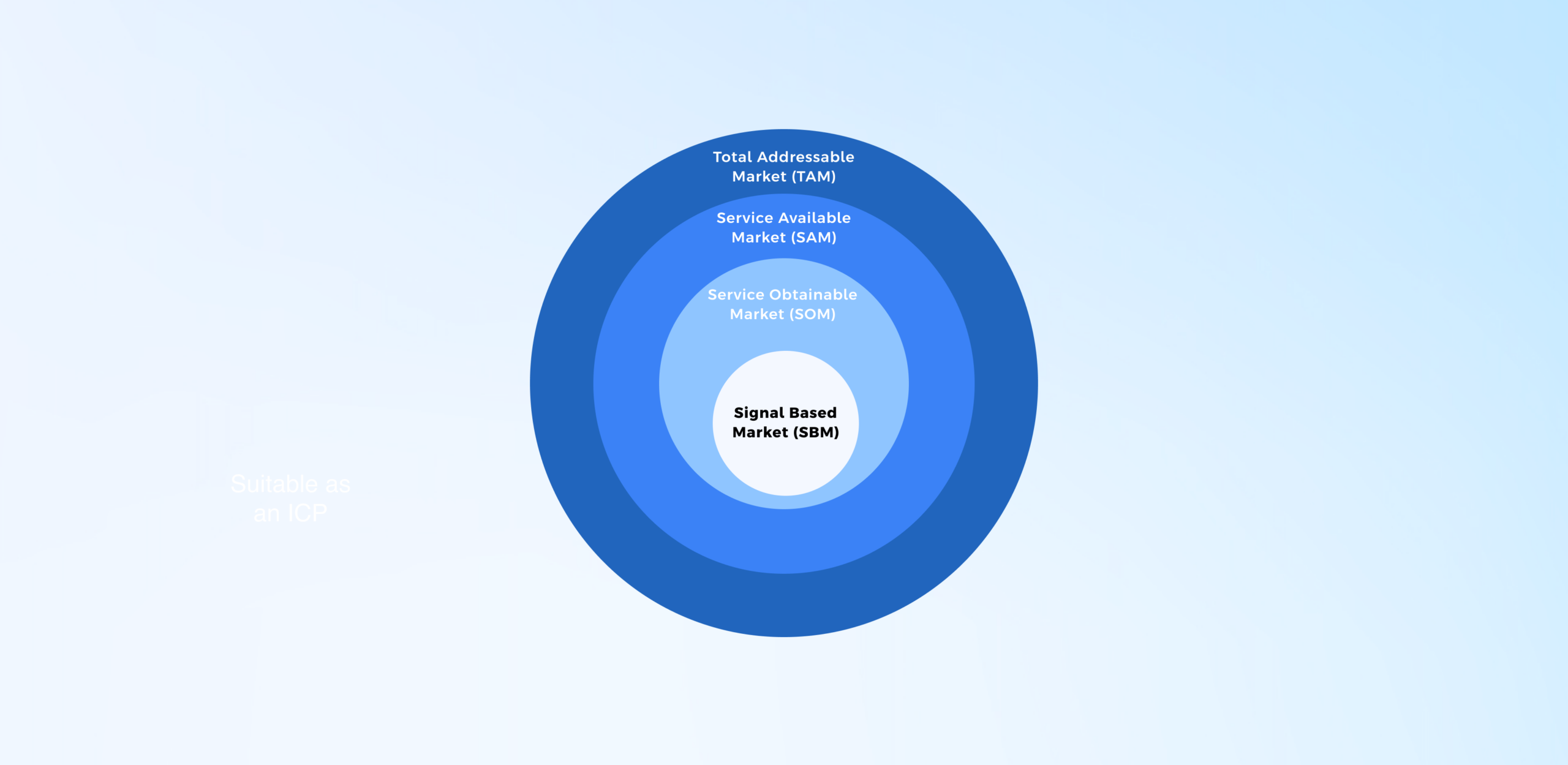Signal based selling is changing how we market and sell SaaS products and I will try to help you build your strategy with best practices, technologies and insights in this post.
How to Create a Signal Based Selling Strategy?
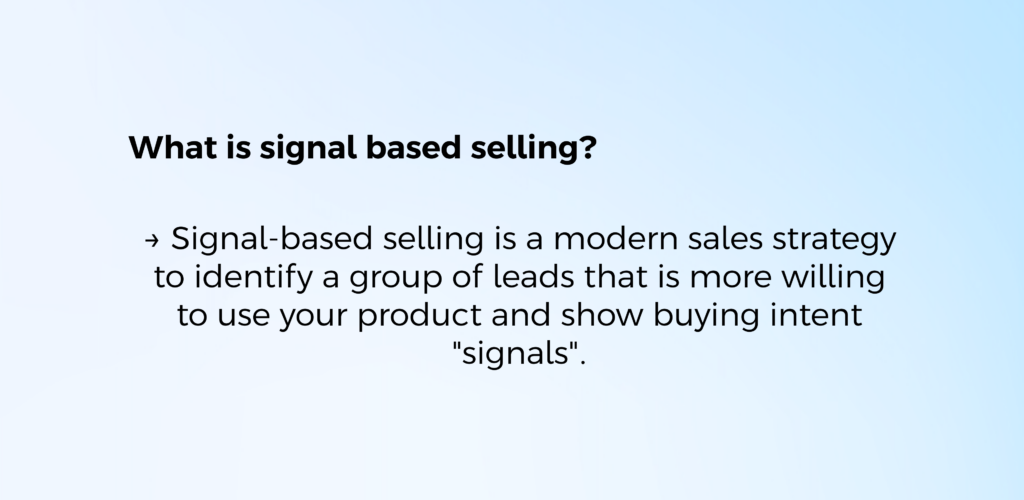
Let me remind you what is signal-based selling again.
→ Signal-based selling is a modern sales strategy to identify a group of leads that is more willing to use your product and show buying intent “signals”.
It is a great strategy for pipeline generation, without sending too many cold emails to put a lead into a pipeline.
Let’s go step by step.
1. Define your SBM Segment
We used to work too hard to get data in hand, while now the online environment is full of data and information. The interpretation is: there are too many signals.
In fact, it is even too hard to parse the data we collect and reach the ultimate buying intent signals.
That’s why defining your segment is the first stage of creating a successful signal-based selling strategy.
I am not saying that you need the leave the old practices out; just define your segment with signals.
You have some frameworks to estimate the potential market size for our product. We call them
- Total Available Market (TAM)
- Serviceable Available Market (SAM)
- Serviceable Obtainable Market (SOM)
Even if these frameworks narrow the potential segment we can target, they do not focus on the real potential, but only make predictions.
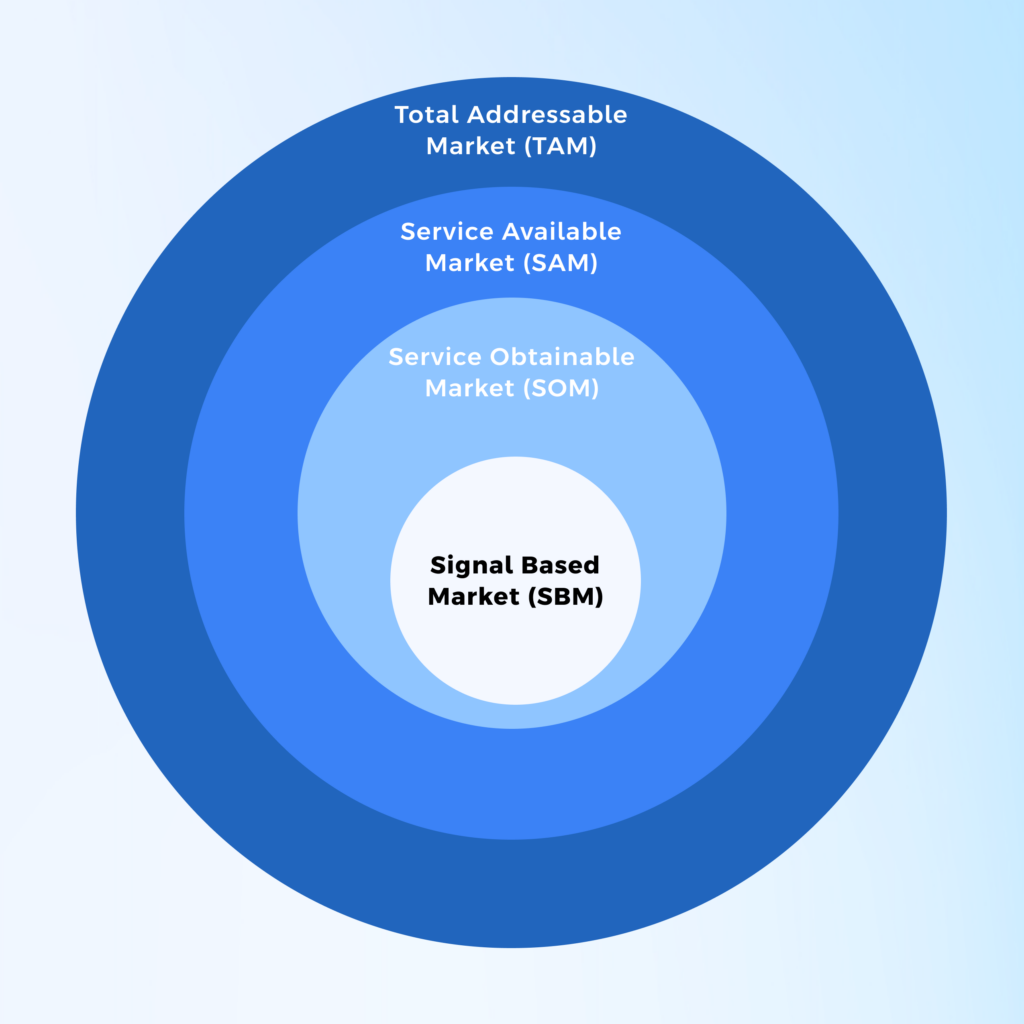
That’s why we need Signal Based Market after all these predictions. TAM, SAM or even SOM does not tell us the exact reason why a company should use our product.
But signal based selling does. Now, you need the signals themselves to define your SBM segment.
2. Intent “Signals”
The signals of signal-based selling can be at company-level or person-level, or might range from direct buying intent to secondary events.
You can define your signals at company level and/or person level, or use direct buying intent signals and/or secondary events.
I know you might be saying it is hard. Yes, it is. Signals have different data sources – they can be find such different places. Let me break it down to you into two categories:
- 1st party data sources
- 3rd party data sources
1st party data sources includes website visits, product usage data, CRM, marketing materials, etc.)
3rd party data sources refers to data acquired from enrichment tools, LinkedIn, B2B databases, tech news, review sites, intent tools, etc.
If you are defining a lead at company-level, the signals can be:
- Accounts that meet ICP criteria and have a high score
- New/relevant technologies detected
- Large population of potential end-users
- Detecting an account using competitor technology
- Detecting an account using a complementary technology
- Competitor’s technology churn
- Executive moves
- Hiring plans
- Layoffs
- Company exits
- Management moves
- New hires
- Opening new positions
- A news event is detected about a company
- When a company receives a round of funding
- Visit from an account to your website
- Visit from an account viewing a specific product or pricing page
- Visit from an account spending X minutes on your pages
- Demo requests
- More than one lead from a single account
If you are defining a lead at person-level, the signals can be:
- Web form submission
- Content download
- Immediate activity
- Chatbot conversation/chatbot conversion abandonment
- Spiking intent data detected
- Viewed a relevant category page on a review site
- View on your company profile on a review site
- View on a competitor profile on a review site
- View on comparison of your product to another competitive
solution - A spike in social engagement
- Attending an event or webinar
- A customer completes their onboarding and training
- A customer has seen positive results
- Providing positive feedback
- Showing a lot of usage activity
There are more of them. So, let’s summarize them based on category:
- Company news
- Product usage
- Job change
- Technologies used
- Engagement on different platforms
- Website visits
- Decision-maker activities
- ICP-fit and high scored leads
- Engaging with marketing materials
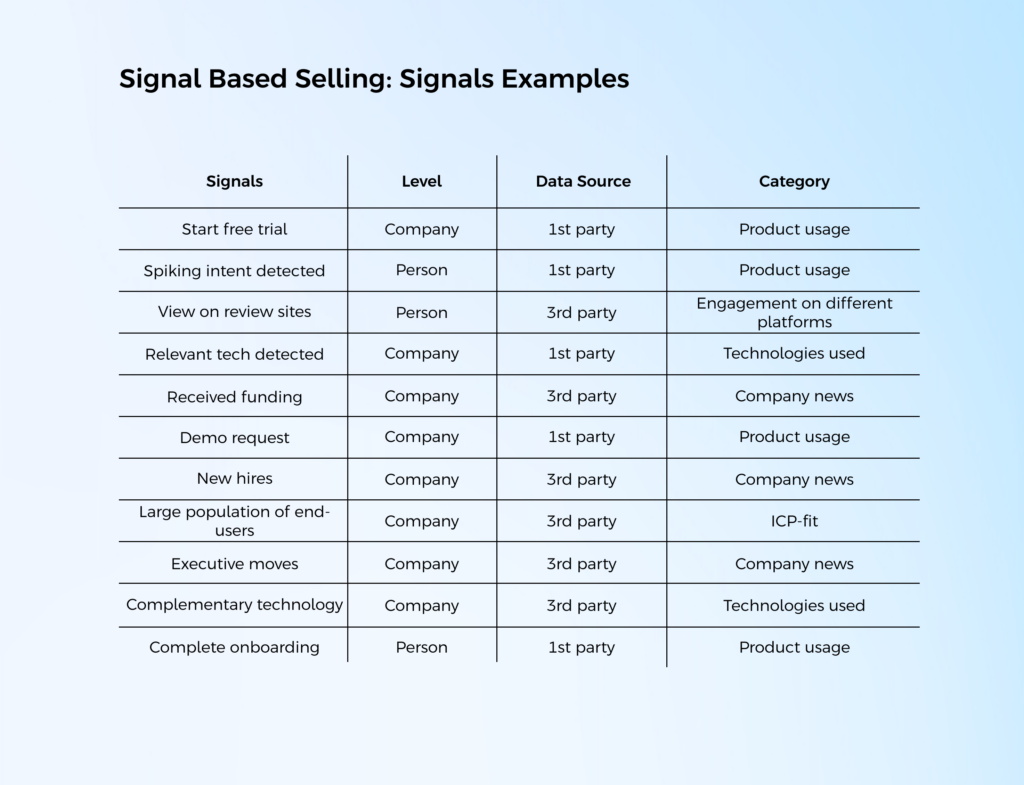
All these signals help you focus on the segment that is can actually buy from you.
And you need to find the ones relevant to your business. Sit with your marketing, sales and product to start shaping yours. Nothing happens if you replace some dailies with these meetings. Your product doesn’t die.
It will start as an experimental attempt, but when you see the results, you will have the insights to review and optimize your segment.
If your leads are not segmented based on these kinds of signals, what else can be? Based on their industry or location? 🙂
3. Pipeline Play
Understand your GTM motion and choose your play wisely.
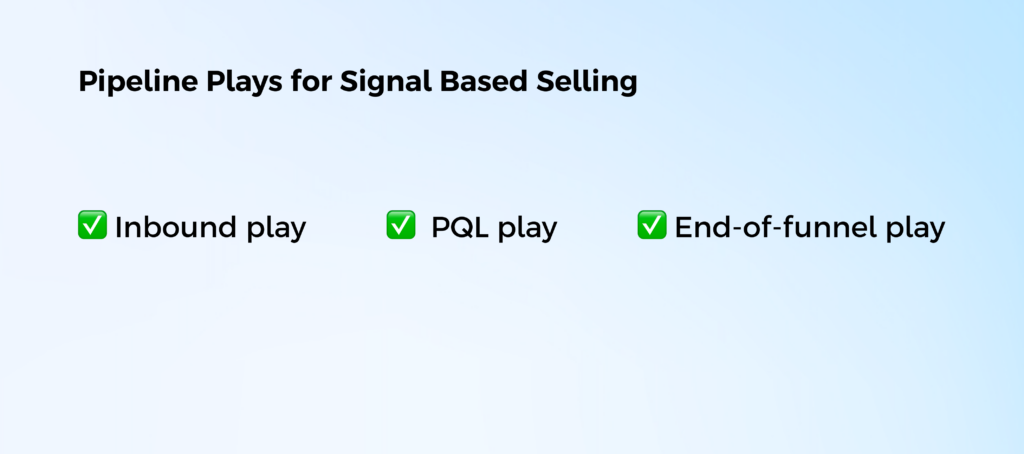
You can apply signal based selling into any part of your sales funnel or pipeline strategy. Most popular plays to run:
- Inbound play
- PQL play
- End-of-funnel play
Each of them are eligible to create an impact with signal based selling.
For example, if your sales strategy is focused on inbound, the funnel starts like:
- A lead visits your website
- A lead starts a free trial (warming up)
- You enrich the account to identify ICP fit
- You track intent “signals”, and if the lead shows multiple and/or enough signals,
- You start nurturing them
- You get sales reps into play, equipped with “intent, relevance and timing”
4. Automations and Technologies
You can automate these plays by using different CRMs like HubSpot or Intercom. Or you can use directly dedicated tools like Apollo.
There are also tools fully focused on ICP fit and intent signals so that you can get any data in hand, but in a way that they score leads.
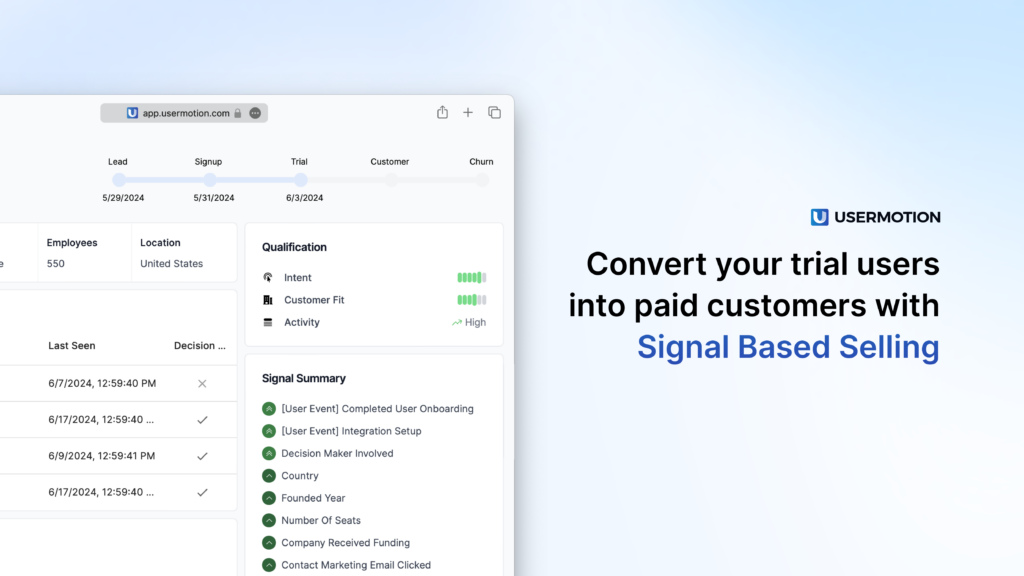
UserMotion is one of them that assign signals to leads when detected, and help you prioritize the ones with the highest score. It does:
- Score your leads based on their alignment with your ICP (BUT THIS IS NOT ENOUGH FOR SIGNAL BASED SELLING)
- Score your leads based on their intent level – low, medium or high?
- List the intent signals for a clear view
- You can assign positive or negative scores to more custom events that are relevant to your business
- You can view account activity, decision-makers and all seats
- You can get REAL-TIME alerts on Slack on high intent leads
- You can analyze your conversion performance and refine your signals
- So, yes, you can build your signal based selling strategy
There are also some other tools like Snowflake (you know that they are big) that shows you events that occurs like “X user done Y”.
Final Thoughts
Signal based selling is the future so if your sales motion is suitable, it is time for implementing a signal based selling strategy to your pipeline. No need to wait.
- Signal based selling is changing lead generation and pipeline generations
- Sales leads and SDRs have more power to generate leads and convert them
- You leave irrelevancy and bad timing in your sales processes
- Targeting at the highest level

